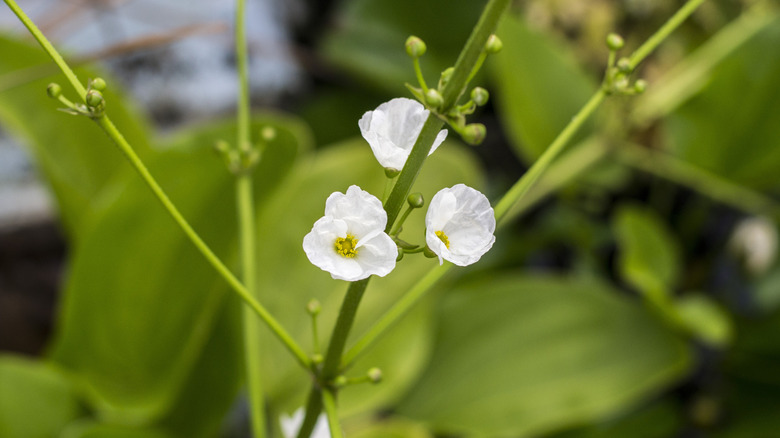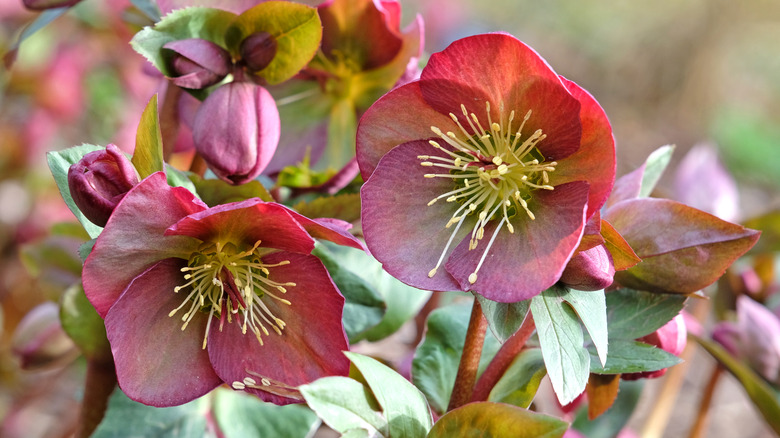The Best Companion Plants To Grow With Skeleton Flowers
Some plants seem magical because they're so skilled at adjusting to their surroundings. Skeleton flowers (Diphylleia grayi) are a perfect example. Also known as umbrella plants, they're best known for their petals, which go from white to clear when water touches them. This makes the blossoms look like they're made of glass. To create an easy-care garden that revolves around these natural wonders, pair them with other plants that have similar light, water, and soil needs. This concept is at the core of companion planting, a gardening technique with benefits that include soil enhancement and pest deterrence. You'll also need to consider where your skeleton flowers' potential companions thrive. In the U.S., skeleton flowers grow best in USDA hardiness zones 4a through 9b. Good companions — Solomon's seal, hellebores, and ferns, for example — will thrive in a similar environment.
Though skeleton flowers' unique look makes them a stunning garden component, their care needs aren't unusual. Since they're woodland plants, they are accustomed to growing in shade. Soil with consistent moisture and ample organic matter also reflects their natural habitat. They love moist air and can't handle hot, dry weather. Starting your companion search with plants from comparable habitats is the best strategy. That's because they're likely to thrive in similar growing conditions. One such plant is common witch hazel (Hamamalis virginiana). Native to parts of North America, this deciduous shrub is content in shady locations and offers yellow spider-shaped blooms. Like skeleton flowers, witch hazel grows at a leisurely pace and prefers rich soil that never dries out completely. Sometimes called southern witch hazel, common witch hazel thrives in zones 3a through 9b.
Woodland perennials to pair with skeleton flowers
Many woodland perennials make ideal neighbors for skeleton flowers. Solomon's seal (Polygonatum biflorum) shares their enthusiasm for dampness and can handle soil that's a bit boggy. These plants are especially fond of loamy soil, just like skeleton flowers, and prefer part to deep shade. Dangling, butterflies love the bell-like flowers that appear in the spring that give way to bird-attracting berries in the fall. Solomon's seal will even grow atop tree roots, and it performs well in USDA hardiness zones 3a through 9b.
Hellebores share skeleton flowers' penchant for shade. Unlike skeleton flowers, which bloom between May and July, these woodland beauties blossom near the start of spring. Their showy flowers come in many colors, including rare hues of green and black. Hellebores with red blooms can even attract hummingbirds, which may eat the aphids that might bother your skeleton flowers. Since hellebores aren't appealing to deer, they may discourage them from nibbling vulnerable species nearby. Most hellebores thrive in zones 5a through 8b, and a few, such as black hellebore (Helleborus niger), are happy up to zone 3.
Consider fern friends for your skeleton flowers, too. The northern maidenhair fern (Adiantum pedatum) is one option. Their feathery fronds complement skeleton flowers' umbrella-shaped leaves, and they're extremely easy to maintain. Plus, they like shade and moist soil at least as much as skeleton flowers. Like hellebores, deer aren't into them, and they're unlikely to become disease vectors since they're not susceptible to most plant pathogens. Though these ferns don't flower, they do attract beautiful songbirds.

